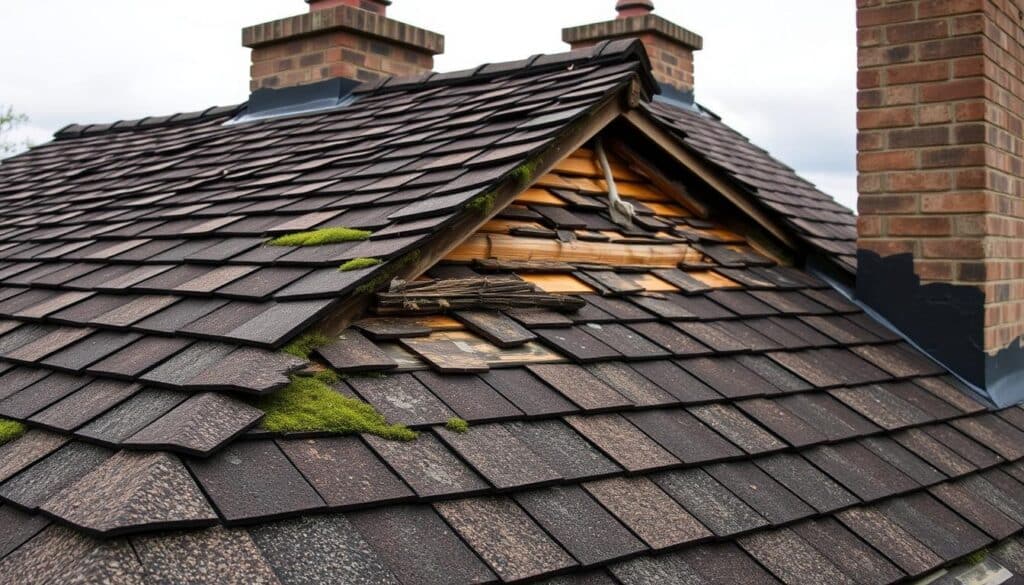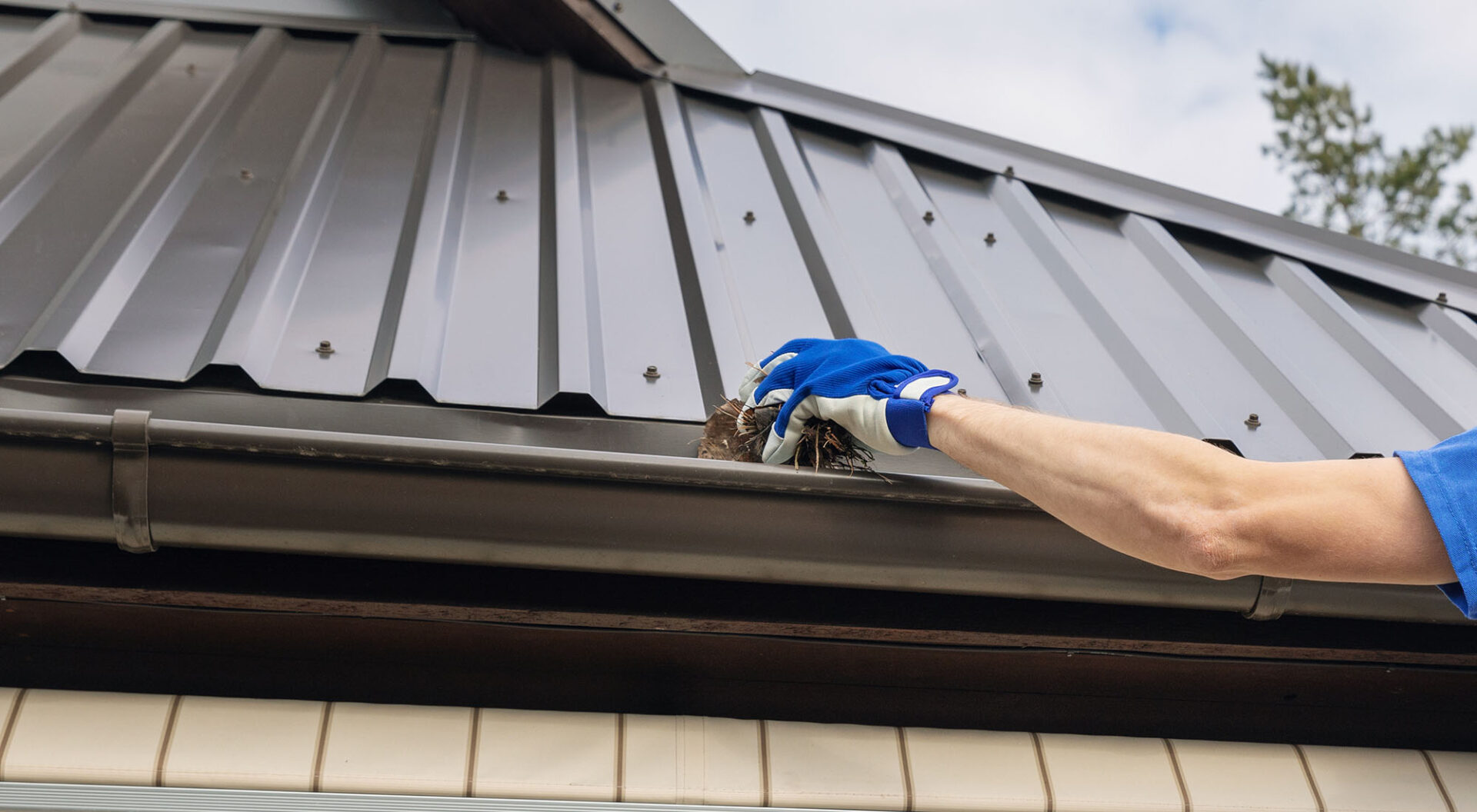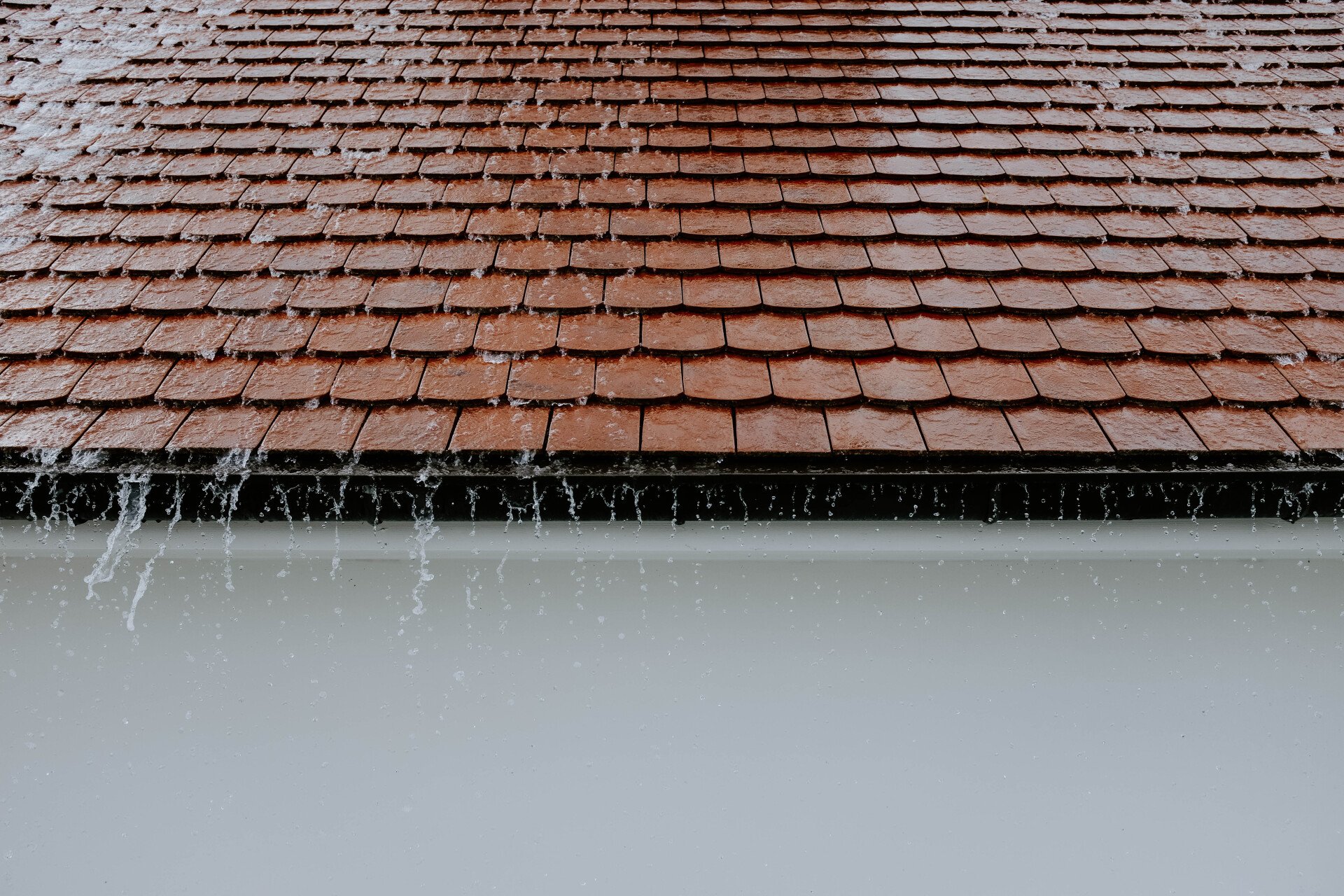Dark streaks, moss growth, or fading patches on your roof can look like a sign of serious trouble, but they aren’t always. In many cases, roof shingles can be professionally cleaned and restored without needing a full replacement. But if the shingles are aging, damaged, or deteriorating beneath the surface, cleaning might only offer a temporary fix. The challenge is knowing what your roof really needs.
In this guide, we’ll explain how to evaluate your shingles, when cleaning is effective, when replacement is necessary, and what experienced roofing professionals consider before answering the question: can roof shingles be repair, cleaned or should they be replaced?
Can Roof Shingles Be Cleaned? Here’s What the Condition Tells You
Before choosing between cleaning and replacement, it’s important to know what shape your roof is really in. Not all stains or discoloration require replacement, but not all damage can be fixed with cleaning either. By examining specific signs like algae growth, granule loss, or curling edges, you can better understand what your shingles need. In this section, we’ll walk through the most common roof conditions and explain what each one means for your next step—whether it’s safe to clean or time to consider a full replacement.
Dark Streaks and Algae Growth
Dark vertical streaks across your roof, especially on the shaded side, are often caused by airborne algae feeding on the limestone in asphalt shingles. While they make the roof appear older or poorly maintained, this issue is mostly cosmetic in the early stages. If the shingles themselves are structurally intact, soft washing with biodegradable solutions is usually enough to remove the stains without harming the roof.
However, algae can hold moisture and gradually break down the surface of shingles if left untreated. This not only impacts the roof’s appearance but also reduces its ability to reflect heat efficiently. Over time, this can raise attic temperatures and put added stress on the material, making timely cleaning an important part of long-term roof maintenance.
Moss and Lichen Buildup
Moss tends to grow in damp, shaded areas of the roof and forms thick, sponge-like patches that retain moisture. Lichen, on the other hand, is a crusty organism that clings tightly to the shingle surface. Both forms of growth are more than just cosmetic concerns—they trap water, which can lead to deterioration of the shingle layers and even damage the roof deck beneath.
Early-stage growth can be removed carefully with soft washing and preventative treatments. But when moss has been growing unchecked for years or has worked its way under the edges of the shingles, cleaning may no longer be enough. In such cases, moisture might already have seeped into underlying layers, calling for repair or even replacement, depending on the extent of the damage.
Curling Shingles
Curling occurs when the corners or edges of shingles lift upward or the center warps downward. This is often a sign of aging, weathering, or improper attic ventilation. Curling reduces the shingle’s ability to shed water, increasing the risk of leaks, especially in heavy rain or snow. It also leaves shingles more vulnerable to wind uplift and breakage.
Cleaning curled shingles is risky. Water from cleaning can easily seep beneath the lifted edges and reach the roof deck, worsening the damage. If curling is limited to a few areas, those sections might be repaired. But if the issue is widespread across your roof, roof replacement is usually the safer long-term solution.
Granule Loss and Bald Patches
Granules on asphalt shingles protect the surface from UV rays and help shed water. Over time, these granules loosen and fall off, exposing the underlying asphalt. You may notice granules collecting in gutters or bald spots forming on the shingles themselves. This makes the roof more prone to heat damage, cracking, and faster aging.
If large areas of the roof are losing granules, cleaning is no longer appropriate. The surface is already compromised, and any pressure—even from soft washing—can accelerate deterioration. In such cases, a full replacement is the most effective way to restore the roof’s protective barrier and prevent future issues.
Cracked or Split Shingles
Cracks can form due to temperature swings, aging, or the constant expansion and contraction of materials. While some cracks are small and isolated, others can spread across the entire shingle or branch outward like a web. These cracks allow water to seep into the roof layers, eventually causing rot or interior leaks.
Cleaning cracked shingles is strongly discouraged. Water from the cleaning process can enter the cracks and reach the underlayment, accelerating damage. A few cracked shingles might be replaced individually, but if cracking is visible in multiple areas, it’s often a sign that the roof is nearing the end of its life and should be fully replaced.
Blistering or Bubbling
Blisters appear as raised bumps or bubbles on the surface of shingles. These often result from moisture trapped within the shingle during manufacturing or from poor attic ventilation. Over time, heat causes the trapped moisture to expand, creating pressure that weakens the shingle from within.
Once a blister pops, it leaves a bare spot vulnerable to UV damage and rapid deterioration. Cleaning blistered shingles isn’t just ineffective—it can rupture the surface further. In severe cases, these shingles lose their protective layer entirely and must be replaced to ensure the roof remains watertight.
Missing or Detached Shingles
Missing shingles leave exposed patches on the roof, allowing water to penetrate the underlayment and potentially the attic space below. These gaps are often caused by wind damage, aging adhesive strips, or improper installation. Any time shingles go missing, the roof’s ability to resist moisture and weather elements is compromised.
Cleaning is irrelevant in this scenario. The structural system is already broken. Small-scale repairs may restore the roof temporarily, but if missing shingles are widespread—or if neighboring shingles are brittle—then a more comprehensive replacement is likely needed to restore full protection.
Roof Sagging or Soft Spots
A sagging roof often looks like a visible dip along the ridgeline or in a specific area of the roof surface. This can be caused by long-term moisture damage, rotted decking, or compromised support beams. It’s a serious structural issue that requires immediate attention.
Soft spots are typically discovered during inspection or when walking on the roof. They feel spongy and unstable underfoot, signaling that the material beneath the shingles is weak or deteriorated. Cleaning a roof in this condition is dangerous and ineffective—replacement of the roofing system and underlying supports is the only safe solution.
Rust Stains from Flashing or Vents
Rust stains show up as orange or brown streaks running from metal roof components like vents, flashing, or chimney caps. These stains don’t usually indicate a problem with the shingles themselves but do suggest that the metal hardware is corroding and may soon fail.
If the staining is limited and the shingles are still healthy, a professional roof cleaning may be enough to improve the appearance. However, the source of the corrosion needs to be addressed first. Ignoring rusted flashing or vents could lead to water entry, even if the shingles themselves remain intact.
Sun Damage and Discoloration
Over time, UV rays can bleach the color from shingles and break down the materials, especially in regions with high sun exposure. The shingles may look faded, brittle, or even slightly warped in some areas. Sun damage also accelerates the aging process, especially on south-facing slopes.
Once shingles become brittle, they’re no longer flexible enough to withstand wind or rain. Attempting to clean sun-damaged shingles can crack or break them further. If your roof shows signs of UV degradation across large areas, a full replacement is usually the safest and most cost-effective approach.
Read More : Roof Replacement vs Repair What’s Best for Your Home
Replacement vs. Cleaning – When Cleaning Isn’t Enough
Even if your roof appears restorable on the surface, there are times when cleaning simply won’t solve the underlying problem. Knowing when to move from maintenance to full replacement is critical for protecting your home’s structure, avoiding repeated repairs, and getting better long-term value from your investment. In this section, we’ll walk through key indicators that your shingles are beyond cleaning and explore the factors that point toward replacement.
When Aesthetic Fixes No Longer Add Value
Cleaning is often done for cosmetic reasons—to remove dark streaks, enhance curb appeal, or freshen up the look of a home before selling. But over time, cleaning stops being a solution and starts becoming a mask. If a roof looks clean for a few months but begins staining again or shows signs of deeper weathering, those aesthetic improvements don’t add lasting value.
At this point, especially for older roofs, buyers and inspectors will look beyond the surface. A freshly cleaned roof might not fool anyone if the material beneath is nearing the end of its life. In such cases, replacement improves both the appearance and structural integrity, offering true value instead of a temporary boost.
Escalating Maintenance Costs Over Time
It’s not just about what cleaning costs today—it’s about the cumulative cost of keeping an aging or weakened roof functional. If you’ve had to clean your roof multiple times, patch small leaks, reseal flashing, or replace individual shingles, the ongoing expense can quietly surpass the cost of installing a new, warranty-backed roof.
When small jobs start stacking up into thousands spent every few years, it’s worth asking whether your maintenance approach is still efficient. A one-time replacement may have a higher upfront cost, but it eliminates the cycle of short-term fixes and provides peace of mind for decades.
Upgrading for Efficiency and Long-Term Protection
Sometimes replacement isn’t just about damage—it’s an upgrade. Older shingles, even if still technically functional, often lack the energy efficiency, wind resistance, or algae resistance of modern materials. If your roof was installed more than 15–20 years ago, there’s a good chance it’s missing newer features that could better protect your home and lower long-term costs.
Shifting from simple asphalt to architectural shingles, or upgrading underlayment and ventilation systems during replacement, allows you to optimize your roof for your current environment—not the one it was built for two decades ago. Cleaning might preserve what’s already there, but it won’t give you these performance benefits.
Read More : What is Soft Wash Roof Cleaning?
When Inspection Reveals Layered or Improper Installation
In some homes, especially older ones, past roofing jobs may have involved layering new shingles over old ones. While technically allowed in some regions, this method can hide damage, trap heat, and reduce the life of the uppermost layer. A roof with multiple layers or signs of shortcuts during past work often isn’t worth cleaning or repairing.
A thorough professional inspection might reveal that cleaning won’t address structural concerns hidden underneath. In these cases, it’s safer—and often required by code—to tear off the roof completely and rebuild it properly. Cleaning a layered or compromised system is essentially treating symptoms, not solving the root problem.
Expert Advice – How Pros Decide Between Cleaning and Replacement
Roofing professionals approach the decision between cleaning and replacement with a structured evaluation process. Rather than relying on surface-level appearances, the focus is on identifying underlying issues that may compromise performance—even if the shingles look intact. This section walks through how experts assess a roof and determine whether cleaning will actually help or if replacement is the smarter, safer choice.
Structural Assessment Goes Beyond Surface Stains
An expert begins with a physical inspection—not just of the shingles but also of the roof’s support system. Walking the surface helps detect soft spots or areas of deck movement that could signal hidden rot. Inside the attic, signs like water stains, mold growth, or light penetration reveal weaknesses that cleaning won’t fix.
Even when stains are present, the recommendation for cleaning depends on how well the underlying layers have held up. If water has been absorbed below the surface, or if insulation is damp, the problem is structural—not cosmetic—and replacement becomes the more responsible choice.
Roofing Age Is Weighed in Relation to Performance
Rather than relying on age alone, roofers evaluate how well the system has performed in local conditions. A 15-year-old roof that’s endured multiple harsh winters, intense UV exposure, or seasonal humidity may be far more deteriorated than a 20-year-old roof in a milder climate.
If shingles are brittle, faded, or showing granule loss, even without active leaks, professionals often recommend replacement to prevent future damage. On the other hand, a roof of the same age with good flexibility and full granule coverage may still be a candidate for cleaning—if other systems are intact.
Read More : Roof Gutter Cleaning vs. Full Gutter Replacement
Use Case and Maintenance Goals Shape the Recommendation
The decision also hinges on how the roof fits into the homeowner’s long-term goals. For a rental property or a house going up for sale, a safe cleaning may be recommended to restore appearance quickly. But for a primary residence where durability and performance matter most, replacement might offer better value—even if the roof is still functional in some areas.
Roof slope, shade coverage, tree proximity, and attic ventilation are also factored into the decision. In environments that encourage recurring algae or moss, upgrading the entire system—rather than cleaning—can reduce maintenance over the next decade.
Warranty and Insurance Concerns Often Influence the Outcome
Cleaning methods must align with manufacturer guidelines to avoid voiding warranties. If high-pressure washing or harsh chemicals have already been used improperly in the past, coverage may no longer apply, making cleaning a risky and limited solution.
From an insurance standpoint, adjusters often review the roof’s condition closely during claims. If shingles are worn, curled, or show signs of early failure, policies may exclude future repairs. A replacement provides more than protection—it can restore eligibility for full insurance coverage and preserve the home’s value in the long run.
Is Your Roof Worth Saving, or Is It Time for a Clean Start?
Deciding between cleaning and replacement isn’t always straightforward, especially when the signs aren’t easy to spot. Delta Roofing Long Island begins with a detailed inspection, not assumptions. If the shingles are in good condition, our soft-wash methods can safely restore the roof’s appearance and performance. When replacement offers better long-term value, we guide you through the process with durable materials and skilled workmanship.
Contact us today for a consultation and make a confident, informed decision about cleaning or replacing your roof shingles.





